C'mon Innistrad, Part 1
Welcome to Week Two of Innistrad previews. Last week I talked about the design of the most radical aspect of the set: double-faced cards. It formed a lot of lively debate and I plan to write an article talking about many of the issues raised, but I'm going to wait until after everyone gets a chance to play with the cards before I write it. Also, there's a lot left to tell about the design of Innistrad and I'm excited to tell it. If you haven't read last week's article, I suggest you do as this week's assumes you have.
Let me start today's column by doing the task I traditionally do at the beginning of the first preview article – introducing my design team. (The story of double-faced cards took up all the space last column.)
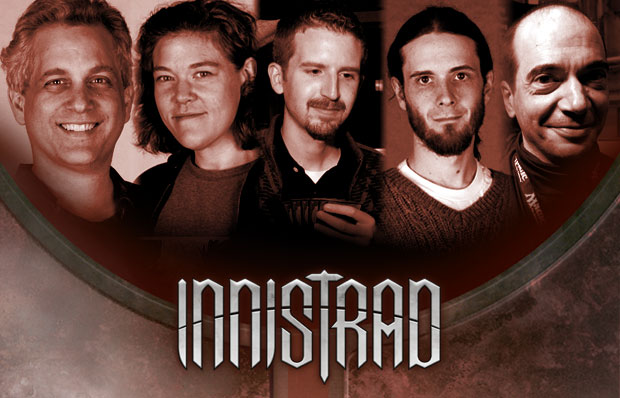
Mark Rosewater (lead designer) – As I mentioned last week, the idea for Innistrad is ten years old. So what took it so long to see print? Well, it was an idea ahead of its time that took me ten years to properly pitch. While the Twilight series had no conscious influence over the design or the creative of this block, the horror resurgence that it brought about was a key factor in helping me convince others that this would be a compelling Magic set. (I'm sure many of you never thought Twilight would bring anything good about.)
I bring this all up because it answers the important question of why I'm leading this set. When one person passionately convinces you of their vision for something that you're a little skeptical in, you really want that person to be overseeing it. I had been promising for years that we could create an awesome set out of the horror genre; it was clear from day one that I was going to have to lead it.
Jenna Helland – Also from day one, I knew this was going to be a top-down design. This meant that I had to integrate the mechanics into the creative from the start. To do that, I needed to have a creative team member on my team. My first choice was Jenna. She seemed very passionate about the set, and I have always been quite impressed with Jenna in all my dealing with her. Jenna, for those who might not know, is very involved in building the worlds of Magic. While other people figure out what the world is going to look like, Jenna helps figure out how the people act and how exactly the world works within all the givens the set has to work with. One of my greatest joys of having Jenna on the team was that not only did she step up as an awesome liaison with the creative team, but she turned out to be a great top-down card designer as well.
Tom LaPille – I like to have a core developer on every design team. They bring an important vantage point that helps us answer questions in design that will later become relevant in development. Also, developers tend to ask important questions that can easily get lost in the vantage point of design. This was the first time I had Tom on a design team (and I think the first non-core design team Tom was on). I explained last week that Tom was the one who first pitched the idea of using double-faced cards. He was also fundamental in piecing together many aspects of the set. Tom, I learned, loves infusing design with flavor, and he was an excellent addition to the team.
Graeme Hopkins – While Ken Nagle probably gets the most press of the original Great Designer Search finalists, he was only one of four designers to end up working at Wizards that are still here to this day. Designing Magic isn't Graeme's day job, but he's good at it, and I stick him on every design team I can. Innistrad design required a very different sensibility than most design teams, and Graeme was up for the challenge. One of the reasons I'm such a big Graeme fan is that he reinvents himself with each set to tailor the work he is doing to the set he is on. Innistrad Graeme, by the way, is an awesome and flavorful designer.
Richard Garfield – Once upon a time, I was just another Magic player. My first job for Wizards was as a contributor to The Duelist magazine doing Magic puzzles (very similar to the challenges in Duels of the Planeswalkers). Richard is a big fan of puzzles and Magic, so he enjoyed Magic: the Puzzling. I remember the first time I ever met him at a small gaming convention. He said a few nice words to me about my puzzles and then invited me up to his hotel room to join him and a bunch of Wizards folk in some games. I was ecstatic.
Flash forward fourteen years, and Richard and I again find ourselves playing games at a gaming event, this time the Magic World Championships in Memphis, Tennessee. In the middle of one of the games, Richard casually says to me, "Mark, you know I'd love to work on another Magic design team. If a spot ever opens up on one of your sets, let me know."
You have to understand that between the two events, Richard and I have been through a lot. We became friends; we worked on a lot of designs together, both Magic and non-Magic; Richard has been on numerous of my Magic design teams (in fact, a large number of Magic design teams Richard has been on were lead by me: Tempest, Odyssey, Ravnica, and Innistrad). Yet through all this, I got the same giddy feeling when Richard asked to join one of my design teams. Luckily, I knew Innistrad was coming up and that Richard loves top-down design, so it was a perfect fit. Obviously, it was a pleasure having him on my team. There's not a lot of people that have an open invitation to be on my design team whenever they wish, but Richard sits atop of that short list.
- Top-Down by the Old Mill Stream
Our story today begins at a point early in last week's column: the very first Innistrad design meeting. After explaining the goal of our set, I had the team brainstorm a list of things that they felt were key parts of the horror genre. Between this week and next week I'm going to go through a number of things we wrote up on the board. Note that for part 1, I'm going to talk about the tribal component of the set, and in part 2 I'll talk about the graveyard design, the other mechanics, and assorted trope-y things.
Zombies
Zombies had a couple of different problems. First was one of the major issues of the design: what I call the "black hole" problem. The five colors of Magic are well balanced overall, but when you dig down into certain genres or tropes you discover there's an imbalance. With horror, I knew walking into the design that black would suck up the entire set if we weren't careful. The overall darkness and creepiness of horror plays right into black's wheelhouse. To offset this, I made a special rule: if something could be done in a color other than black, we would do it in that color.
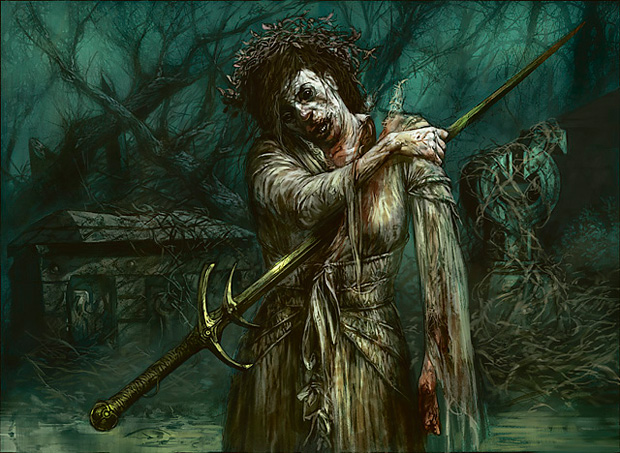
Diregraf Ghoul | Art by Dave Kendall
A quick aside: design actually capitulated slightly and made more black cards. Not anything as extreme as Torment, but it became clear that black wanted more cards than the other colors, so we let black have a little more. Development decided not to go with that plan because it caused all sorts of chaos with Limited.
Zombies were impossible to get completely out of black. In normal Magic, they are one of the staple black races. The big question was whether we could find a second color that made logical sense. The reason I like having races in at least two colors in sets with tribal components is that it allows the players much more flexibility with what to do with the tribe. I was always unhappy that Onslaught's tribes had so few options for how to play them. You can see my desire to push tribes into two-plus colors in how Lorwyn played out.
Back to the Zombie two-color issue. The answer to it got solved by the gothic horror setting itself. When we first talked about zombies, Jenna, as the creative team rep, pointed out that what I'll call Dawn of the Dead zombies are actually a rather modern invention. Gothic horror did have zombies, but they were much closer to Frankenstein's monster–type creations (sometimes called flesh golems in fantasy) than anything done by George Romero.
I said that while I didn't mind having flesh golems, I still wanted the more traditional zombies. My argument is that they had become so ingrained in horror that taking them out would feel awkward. Players coming to a horror set would expect them. Having two kinds of zombies, though, made it much easier to get to a second color. The Dawn of the Dead zombies could stay in black where they've always been. The Frankenstein's monsters / flesh golems, though, could play into a theme we wanted to explore in blue: the mad scientist. Blue has always been about knowledge, so the idea of crazy men doing horrific experiments in a search for knowledge felt perfect for blue.
Quick aside: I understand that the actual Frankenstein's monster in the novel Frankenstein is very different from the archetype I am talking about. Just as the modern perception of zombies has shifted, so too has what I will call "Halloween Frankenstein" shifted how people see flesh golems.
As this was top-down design, we also realized that the two types of Zombies wanted to play differently. For the black Zombies I was interested in building a Zombie deck I'd never seen. Magic has had a few Zombie decks over the years, but they tend to be fast and aggressive (more like what are sometimes called zoombies). That's not how zombies work in an archetypal zombie apocalypse story. Zombies individually are slow and not particularly hard to kill.
I was very eager to make a Zombie deck that slowly built up over time, creating an army of zombies that overwhelm you. We accomplished this through several means. First, we made more spells and abilities that can get Zombies out of the graveyard and back into the hand or battlefield. Second, we gave Zombies a strong token making theme. Third, we created some cards that made it easier to get Zombies onto the battlefield. All those cards added together to create the feel we needed.
Which brings us to my preview card today. One day in design, I told my team we were going to design some cards in the meeting. What I wanted was an awesome mythic rare for each of our relevant creature types.
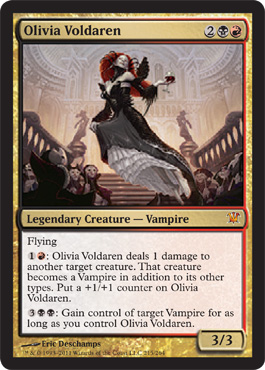
Olivia Voldaren was the mythic rare Vampire we created in that meeting. (The mythic rare Werewolf, by the way, got pushed off to later in the block when Garruk Relentless took over the only mythic rare double-faced card slot. And no, here's not a Werewolf.) My preview card for today was the kick-ass mythic rare zombie card we made. I don't want to spoil it, so let's just let it speak for itself (and then I'll speak for it).
Click here.
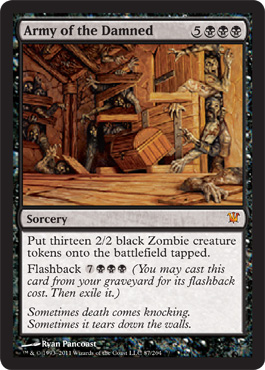
Yes, in the end we decided that the scariest thing about zombies isn't any one zombie, but a large horde of zombies. Scathe Zombies aren't scary, but how about thirteen Scathe Zombies? How about twenty-six? The "enter the battlefield tapped" text you'll see on a few of the Zombies is our attempt to convey the flavor of them being slow.
The blue Zombies ended being the Frankenstein's monsters. At first, all of our blue Zombies required you to exile one or more creatures from a graveyard as an additional cost, but playtesting showed that to be a little overbearing. In the end, we mixed and matched the blue Zombies. Some help you fill up the graveyard, while others use the graveyard as a resource. Also, to separate the blue Zombies from the black, we made the blue versions a little tougher. Black Zombies are easily mowed down, less so the Zombies built in the lab.
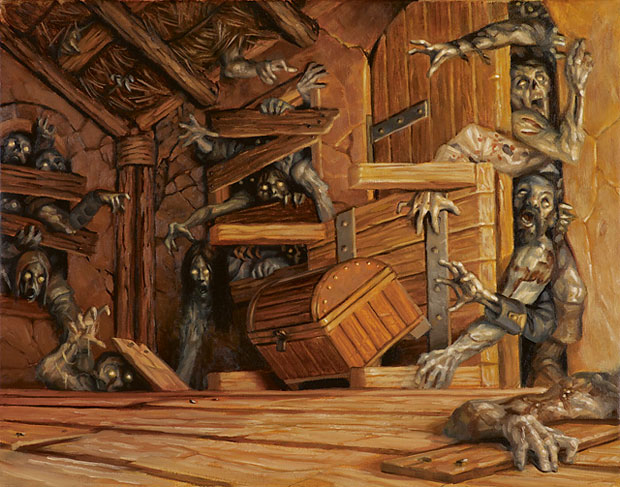
Army of the Damned | Art by Ryan Pancoast
All in all, I'm very happy with how the Zombies turned out. (Ga'Aark would be proud.) One of my goals was to make the cards not only look flavorful but play flavorfully. I am very happy with the feel of the Zombies and I can't wait for all you Zombie fans out there to try them out.
Werewolves
During the ten years it took to make Innistrad a reality, I always knew one thing: when we made the set, it was going to have werewolves. For some reason, Magic has never really delivered on werewolves. In over twelve thousand cards, we had made three, none of which were anything spectacular. If we were going to do horror, especially gothic horror, werewolves would have to play a major role.
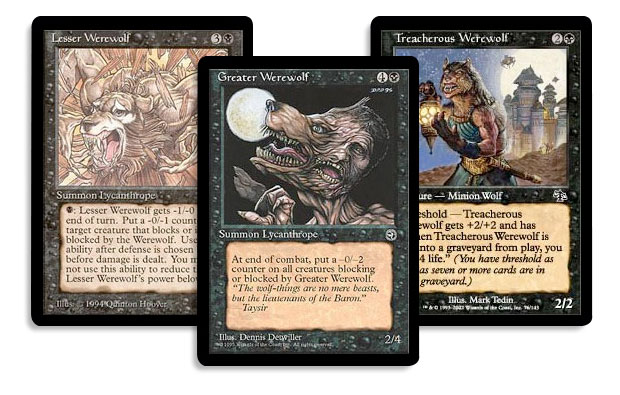
The first issue we tackled was the color one. Were there two colors that we could put werewolves in that weren't black? (Notice that all three existing werewolves are black.) The first obvious choice was green. Werewolves are essentially wild animals. They hunt in packs and are quite feral. It's not hard to see them as green creatures. For the second color, I pushed the idea of red.
The reason I liked red is that each monster in horror tends to represent some human flaw. Werewolves represent repressed anger. The idea that the werewolf allows the person to finally act on their impulses felt very red. While there was some discussion among our design team and others, I felt strong about red as the second werewolf color. Green and red—we had our werewolf colors.
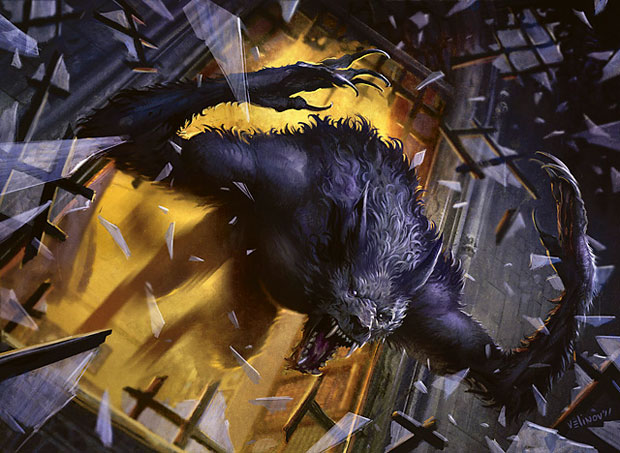
Howlpack Alpha | Art by Svetlin Velinov
The rest of the Werewolf story is compelling and long. To do it justice will take an entire column. As our first post-preview theme week is going to be Werewolf Week, I've decided to hold off on this story until then. It's just a few weeks away, I promise. In that article I'll tell you everything you wanted to know about how we designed Werewolves and how we came up with the Werewolf transformation mechanic.
Vampires
Both Zombies and Werewolves had some untapped design space I wanted to explore. I knew the set wanted Vampires, but I didn't know exactly what Innistrad had to offer the tribe. The one thing I did know was that if we were going to have a tribal component I wanted to get each of the major creature types into at least two colors, for reasons I stated above.
Black was an automatic for Vampires. Not only were they black's current staple race, but their very essence plays perfectly into black's parasitic nature. The question was which color made the most sense as the second color. There is an argument for blue. Vampires have many qualities—shapeshifting, turning to mist, mind control—that feel very blue in nature. The biggest problem with blue was that zombies were already in blue-black, and I knew I didn't want two races in the same color space.
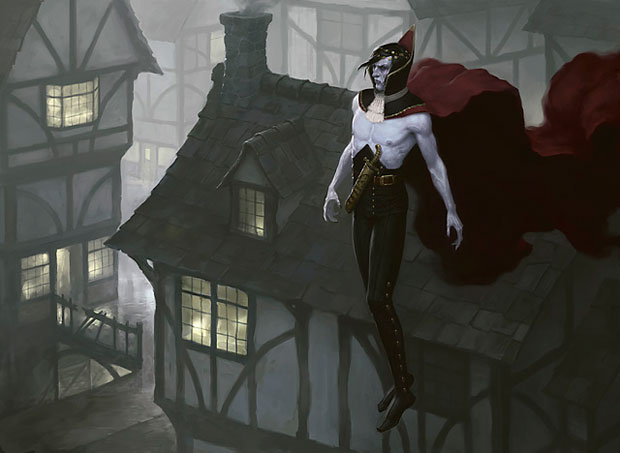
Vampire Interloper | Art by James Ryman
White and green both felt out of place for vampires, so I turned to the only color remaining: red. The more I thought about red Vampires, the more excited I got. Gothic horror has a lot of passion in it, and I loved the idea of vampires so caught up in their bloodlust that they simply cannot control themselves. Also, if werewolves are about repressed anger, vampires are about repressed lust, and nobody does lust like red. The idea of vampires driven by their impulses sounded pretty cool. Also, the set was lacking a more aggressive race, and black-red Vampires seemed like a good fit. (Perhaps Tom LaPille will explain one of these days why black-red is not as good an aggro pair as one might first assume. Making the vampires into an aggro deck was one of the big challenges of development.)
The Vampire "Slith" ability (getting the +1/+1 counter when they deal combat damage to other players) was put in during development to make players want to attack more with their Vampires. Design had tried some different ways to encourage attacking, but I agree that the Slith ability worked better than the hodge-podge collection of cards we put in.
Humans
The first thing we wrote up on the whiteboard during our brainstorming was a list of monsters. Right after that we wrote "Victims," followed by "Monster Hunters." When you study the horror genre, you'll find that humans are a key part of it. They are the thing the monsters prey on, they are the thing the monsters come from, and they are the thing that fights back and slays the monsters. If we were going to do the horror genre justice, humans had to play a major role.
Another thing we were trying to do in Innistrad was to create a stark contrast to the Scars of Mirrodin block. Scars was all about a conflict between two sides. For Innistrad we wanted a very different feel. The humans are the protagonists of Innsitrad block. This block is their story. As we begin, we find the humans hunted on all sides. Unlike in Scars, the bad guys aren't working together. Each monster has its own agenda, part of which is wiping out the humans or turning them into monsters.
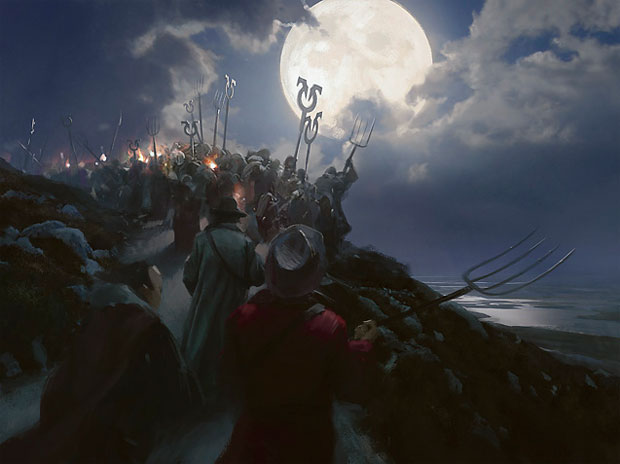
Art by Jaime Jones
To get this feeling of isolation, we put the humans in white and then isolated white from the other four colors. To help hammer this home, we made a number of four-card cycles that specifically skip white. This helps create the feeling that the humans are all alone.
Another big move we made was, for the first time, to create Human tribal. When the race/class model was first created during Mirrodin block, Human was added as a race because it felt odd for us to mention every race but Human. At the time, we decided that while we would use Human as a creature type, we would refrain from using it tribally.
For many years, we have never crossed the streams between Humans and tribal mechanics, but as we laid out Innistrad design, it became clear that the humans played a central role in the block. If we were going to get players invested in playing Humans, we had to mechanically encourage it which meant we needed to dip into the Human tribal well. There was some resistance, but as design started crafting the feel of the Humans we got everyone on board.
We decided to give the Humans two major strengths. One, they worked well in number. This played into a strength white already had. Second, we liked the idea that tools were often the most deadly in the hands of a human. Monsters don't really need tools, but our poor victims and slayers definitely did, so we made a bunch of Equipment that is improved in the hands of a human.
Ghosts (Spirits)
Sometimes in design things are planned out, and sometimes they fall into your lap. So, after laying out our key four races we found that we had two races in black and red, and one each in white, blue, and green. After looking everything over, there was one logical move: find a monster race for green-blue and finish off the monster portion of our design. White would be the only human color as it was facing off against all the monsters.
Remember that the set was always going to have a lot of creature types that only showed up in ones and twos. We just had to figure out which one we could blow up into another major race. In the end, I was swung by breakfast cereal. In 1975, General Mills put out five monster-themed cereals: Count Chocula, Franken Berry, Boo Berry, Fruit Brute, and Yummy Mummy. Obviously, General Mills was trying to go with the most popular monsters. Vampires, zombies, and werewolves were all represented.
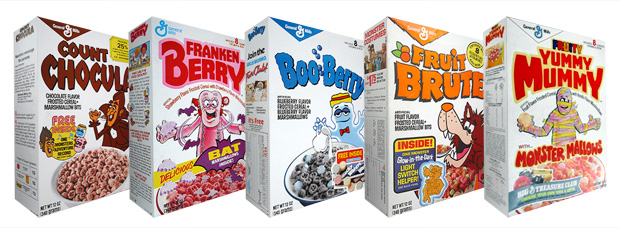
The remaining two were ghosts and mummies. Mummies felt too Egyptian to make sense in gothic horror, so that left ghosts, or spirits as Magic creature types call them. The problem with ghosts is that they didn't make a lot of sense in green. For starters, ghost really like to fly. and green is just not a flying color. Also, the horror genre tends to have two different kinds of ghosts: benign and malevolent.
The more we talked about it, the more I realized that there were two perfect colors for ghosts: white and blue. Blue could be the mean ghosts, while white would be the nice ones. That would allow us to keep white versus the rest of the colors. Because we wanted ghosts in more places flavor-wise, we also decided that unlike the other races, we would allow spirits to bleed into all the colors, but they would be centered in blue and white.
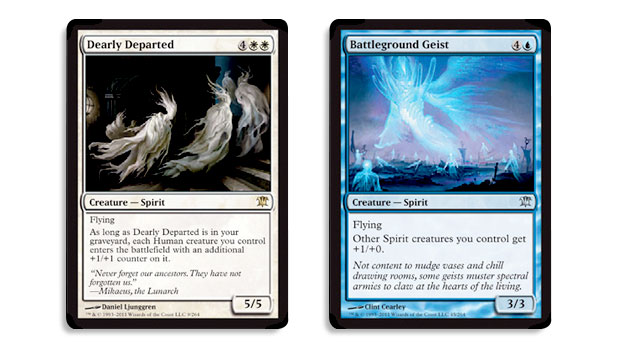
The only problem is that the solution created one hole. Everyone had two races except green. Also, every race had an ally=color pairing. The obvious solution was to branch out humans. They were already in green due to the Werewolves—Humans, like Spirits, show up in all five colors—so we decided to beef up their appearance in green and make that the secondary Human color. The reason Elves don't show up in this block was partially because they didn't fit favor-wise and partially to make room for more Humans in green. This allowed us to make a complete cycle of ally-color pairings.
Ghosts always had a strong flying theme, but development added another key component: the flavor of humans dying into spirits. The design team had played into this theme a little. The development team liked it and blew it up into a larger theme.
- Moving Innistrad
We've run out of time for today, so make sure to join me next week when I continue our run-down of the white board of horror tropes. As you'll see, we crammed a lot in.
Until then, may you enjoy the things that go bump in the night.
- So You Want to Work at Wizards?
One last thing. One of the most common questions I get is, "How can I get a job at Wizards?" Today, I have a nice simple answer: click on this link. There are a number of jobs currently available, including some positions in Ramp;D and an editor for this very website. (Current editor Kelly Digges is joining us in Ramp;D.) Interested? Take a look.






